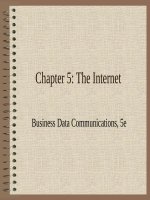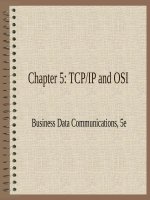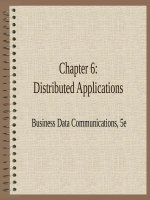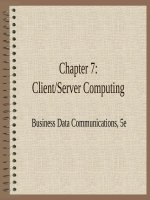Business data communications 5e by stallings chapter 10
Bạn đang xem bản rút gọn của tài liệu. Xem và tải ngay bản đầy đủ của tài liệu tại đây (252.71 KB, 39 trang )
Chapter 10:
Ethernet and Fibre Cable
Business Data Communications, 5e
Increase in High-Speed LANs
• Extraordinary growth in speed, power, and
storage capacity of PCs
• Increasing use of LANs as computing
platforms
• Examples
– Server farms
– Workgroups with “power” requirements
– High-speed backbones
Business Data Commun
ications, 5e
2
Increase in High-Speed LANs
• Fast Ethernet and Gigabit Ethernet
• Fibre Channel
• High-speed Wireless LANs
Business Data Commun
ications, 5e
3
Characteristics of
Some High-Speed LANS
Business Data Commun
ications, 5e
4
Trends Influencing Emergence
of High-Speed LANs
• Explosive growth of speed and computing
power of PCs
• Recognition by MIS organizations of the
value and importance of networked
computing
– Centralized server farms
– Power workgroups
– High-speed local backbone
Business Data Commun
ications, 5e
5
Traditional Ethernet
• Ethernet and CSMA/CD (IEEE 802.3)
• Carrier sense multiple access with collision
detection
• Four step procedure
–
–
–
–
If medium is idle, transmit
If medium is busy, listen until idle and then transmit
If collision is detected, cease transmitting
After a collision, wait a random amount of time before
retransmitting
Business Data Commun
ications, 5e
6
Ethernet MAC Frame Format
•
•
•
•
•
•
•
•
Preamble: 7-octet pattern of 0s &1s used to establish bit
synchronization.
Start Frame Delimiter (SFD): Indicates actual start of frame.
Destination Address (DA): Specifies the station(s) for which the
frame is intended
Source Address (SA): Specifies the station that sent the frame.
Length: Length of LLC data field in octets.
LLC Data: Data unit supplied by LLC.
Pad: Octets added to ensure that the frame is long enough for proper
CD operation.
Frame Check Sequence (FCS): A 32-bit CRC, based on all fields
except preamble, SFD, and FCS.
Business Data Commun
ications, 5e
7
Ethernet MAC Frame
Business Data Commun
ications, 5e
8
802.3 Medium Notation
• Notation format:
<data rate in Mbps>
• e.g 10Base5 provides 10Mbps baseband,
up to 500 meters
• T and F are used in place of segment length
for twisted pair and fiber
Business Data Commun
ications, 5e
9
802.3 10BaseX Media Options
Business Data Commun
ications, 5e
10
Bridges
• Allow connections between LANs and to WANs
• Used between networks using identical
physical and link layer protocols
• Provide a number of advantages
–
–
–
–
Reliability: Creates self-contained units
Performance: Less contention
Security: Not all data broadcast to all users
Geography: Allows long-distance links
Business Data Commun
ications, 5e
11
Bridge Functions
• Read all frames from each network
• Accept frames from sender on one network that are
addressed to a receiver on the other network
• Retransmit frames from sender using MAC protocol
for receiver
• Must have some routing information stored in order
to know which frames to pass
Business Data Commun
ications, 5e
12
Bridge Operation
Business Data Commun
ications, 5e
13
Key Aspects of Bridge Function
• Makes no modification to content or format of
frames it receives; simply copies from one LAN
and repeats with exactly the same bit pattern as
the other LAN.
• Should contain enough buffer space to meet peak
demands.
• Must contain addressing and routing intelligence.
• May connect more than two LANs.
Business Data Commun
ications, 5e
14
Hubs
• Alternative to bus topology
• Each station is connected to the hub by two lines
(transmit and receive)
• When a single station transmits, the hub repeats
the signal on the outgoing line to each station.
• Physically a star; logically a bus.
• Hubs can be cascaded in a hierarchical
configuration.
Business Data Commun
ications, 5e
15
Two-Level Hub Topology
Business Data Commun
ications, 5e
16
Layer 2 Switches
• Also called a “switching hub”
• Has replaced hub in popularity, particularly for
high-speed LANs
• Provides greater performance than a hub
• Incoming frame from a particular station is
switched to the appropriate output line to be
delivered to the intended destination
• At the same time, other unused lines can be used
for switching other traffic
Business Data Commun
ications, 5e
17
Ethernet Hubs and Switches
• Shared
medium
hubs
• Switched
LAN hubs
x
Business Data Commun
ications, 5e
18
Advantages of Switched Hubs
• No modifications needed to workstations
when replacing shared-medium hub
• Each device has a dedicated capacity
equivalent to entire LAN
• Easy to attach additional devices to the
network
Business Data Commun
ications, 5e
19
Types of Switched Hubs
• Store and forward switch
– Accepts a frame on input line
– Buffers it briefly
– Routes it to appropriate output line
• Cut-through switch
– Begins repeating the frame as soon as it
recognizes the destination MAC address
– Higher throughput, increased chance of error
Business Data Commun
ications, 5e
20
Differences Between
Switched Hubs and Bridges
• Bridge frame handling is done in software. A layer 2
switch performs the address recognition and frame
forwarding functions in hardware.
• Bridges typically only analyze and forward one frame at
a time; a layer 2 switch can handle multiple frames at a
time.
• Bridges uses store-and-forward operation; layer 2
switches use cut-through instead of store-and-forward
operation
• New installations typically include layer 2 switches with
bridge functionality rather than bridges.
Business Data Commun
ications, 5e
21
Problems With Layer 2 Switches
• Broadcast overload
• Lack of multiple links
• Can be solved with subnetworks connected by
routers
• However, high-speed LANs layer 2 switches
process millions of packets per second whereas a
software-based router may only be able to handle
well under a million packets per second
Business Data Commun
ications, 5e
22
Layer 3 Switches
• Implement the packet-forwarding logic of the router in
hardware.
• Packet-by-packet switch operates like a traditional router
– Forwarding logic is in hardware
– Achieves an order of magnitude increase in performance
compared to software-based routers
• Flow-based switch identifies flows of IP packets that
have the same source and destination
– Once flow is identified, a predefined route can be established to
speed up the forwarding process
– Again, huge performance increases over a pure software-based
router are achieved
Business Data Commun
ications, 5e
23
Why Use Ethernet for
High-Speed Networks?
• Negative
– CSMA/CD is not an ideal choice for high-speed LAN
design due to scaling issues, but there are reasons for
retaining Ethernet protocols
• Positive
– Use of switched Ethernet hubs in effect eliminates
collisions
– CSMA/CD protocol is well understood; vendors have
experience building the hardware, firmware, and
software
– Easy for customers to integrate with existing systems
Business Data Commun
ications, 5e
24
Fast Ethernet
• Refers to low-cost, Ethernet-compatible
LANs operating at 100 Mbps
• 802.3 committee defined a number of
alternatives to be used with different
transmission media
Business Data Commun
ications, 5e
25









